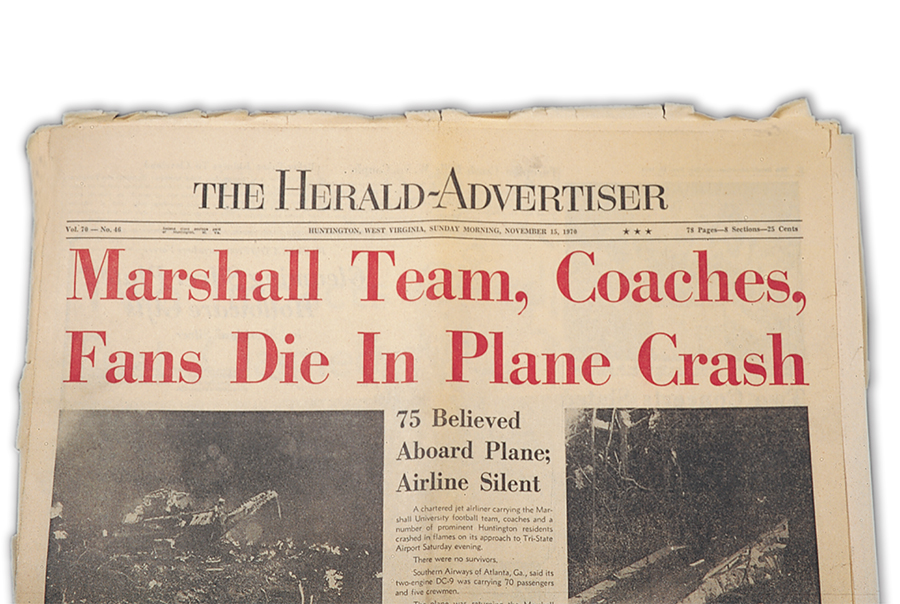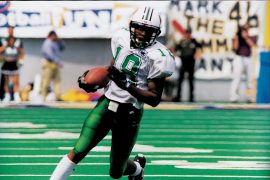The story behind the most disastrous day in American sports history.
By Marla Brannan
HQ 60 | WINTER2007
Even before “We Are Marshall” brought the stars and movie-making to the region, most Huntington area residents had some idea of what happened November 14, 1970. For many, the story ran through their veins by personal relation to the tragedy; for some, it weaved its way in and out of their lives as they came into contact with relatives and friends of the victims; for all who lived here at the time, it left an indelible mark, an impression on the mind’s eye.
But what about non-natives from other states or countries, those who were too young to remember or those who hadn’t been born? What actually occurred on the night everyone talks about?
Marshall’s Thundering Herd football team went through a transition in the late 1960s. Brought on by the belief that West Virginia University was the university in the state and sick of being ignored, Marshall recruited players using money as incentive. Caught and put on probation by the NCAA and suspended from the Mid-American Conference, Marshall’s 1970 team was depleted by players dropping out of school or transferring to other universities. They began the season with only 40 players. “Marshall” and “football” were not synonymous in this pre-Pennington, pre-Moss, pre-championship era. In fact, the basketball program was better known and held in higher regard at that time.

Because most of The Herd’s rival schools were in West Virginia, Kentucky and Ohio, they traveled by bus to every other game played during the fall of 1970. But for their ninth game of the season against East Carolina, the school chartered a twin-engine DC-9 from Southern Airways. Thirty-seven players, twenty-five supporters, eight coaches and five crew members boarded the flight in Greenville after yet another heartbreaking loss, this one 17-14. No member of the crew had flown in or out of Tri-State Airport, as the crew returning to Huntington was not the same one that had flown into Greenville; however, the pilot, Capt. Frank Abbot, had logged more than 20,000 miles flying time.

It rained. It was foggy. Due to budget constraints and the absence of large portions of level land, Tri-State Airport was not equipped with the “Glide Slope” portion of the Instrument Landing System that would have helped establish the pilot’s landing path and given him altitude. At 7:37 p.m., the jet clipped some trees, crashed and burned about a mile-and-a-half from the runway. All 75 souls on board were lost.
At first all anyone knew was that a crash had occurred. The first United Press International (UPI) wire on the subject, dated Nov. 14, read “A DC-8 [sic] passenger plane is down near Huntington’s Tri-State Airport this evening. Authorities say the wreckage has been located somewhere near the area of where the Interstate 64 bridge crosses the Big Sandy River outside of Huntington … There is still no word on possible injuries.” Eyewitnesses, without knowing who was on the plane, described earth-shaking booms and a conflagration no human could have survived.

Early the following day, the bleak truth surfaced. The next UPI wire described who was on the plane and the basic details of the crash. The wire went on to say: “National Guardsmen, State Police and volunteer firemen have begun the grim task of removing (the) bodies … they will be taken to the National Guard Armory where a team of identification experts will begin the tedious process of attempting to identify the victims. Parts of the plane in the surrounding heavily wooded area still are burning four hours after the crash occurred … The main fuselage can be seen from the highway. A cockpit, however, is located behind the main section of the plane.”

Six of the victims recovered from the plane could never be positively identified. They were assigned football team members’ names by process of elimination and are buried at Spring Hill Cemetery under a memorial monument.
Investigations into the crash were inconclusive. All systems seemed to be operating properly and communication between the tower and crew was normal. After the crash, one official noted that, in a literal sense, if it hadn’t been for the trees, the plane most likely would’ve been able to land.

November 14, 1970 remains the most disastrous day in all of American sports history. The rebuilding of Marshall’s football program and the Huntington community is a miraculous story and certainly well worth portraying on the silver screen. For those few players and coaches who didn’t make the trip and for the families of the victims, the film will serve as yet another step in the healing process.





